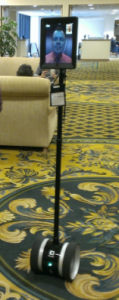 I spent last week at ELI in New Orleans, the US eLearning Conference run by Educause. My main purpose for attending was to find out more about what US institutions are doing with Learning Spaces, but as always with ELI I learned so much more, everything was interesting from Robot participants to Neurology lectures.
I spent last week at ELI in New Orleans, the US eLearning Conference run by Educause. My main purpose for attending was to find out more about what US institutions are doing with Learning Spaces, but as always with ELI I learned so much more, everything was interesting from Robot participants to Neurology lectures.
While I have attended conferences with virtual online participants many times before, this was my first conference with actual robot participants. Like giant iPads showing the participants faces on sticks with wheels, the robots zoomed in and out of sessions, participating in questions, and joined in with coffee breaks and social events. Each robot had a participant on a webcam at the other end, using their computer controls to drive from the comfort of their office. While I found interaction with these participants easy, and I did have a chat with one or two of them, I’m not entirely convinced they got the full conference experience, however it was rather amusing for those of us there in person to watch them repeatedly drive into, and collide with closed doors, walls, posters, people and drinks stands.
The first keynote of the conference was a neurology lecture about the way in which the brain learns by John Medina. After first debunking lots of myths about the way in which the brain works (we use far more than 10% of it, there is no such thing as left and right brained people etc), he aptly pointed out that if you were to design a learning environment that goes against the way our brains naturally learn, you would build a classroom.
He went onto explain that memory is a combination of crystallised intelligence and fluid intelligence, with crystallised being the attainment of information, and fluid memory being the ability to do something unique with it. One point he was clear about was that memory is not fixed at the moment of learning, repetition at very specific timed intervals provide the fixture.
Your memory can hold 7 items at any one time, but only for 30 seconds, if an item is not repeated within that 30 seconds your brain will dump the information. At this point it is added to your working memory where you have two hours to repeat the information again, or your brain will dump the information, if repeated within those two hours you will have now memorised it.
He used this to illustrate that in schools and universities we often have several hours of declarative information with no repetition, meaning that by the time our students get home and revise from books, they are no longer revising something they have already learned, they are in fact learning the information again from scratch. I thought this had interesting implications for our pedagogic models. Illustrating the importance of things like quizzing students with PRS at the end of a lecture, or asking them to do some group exercises or discussion that engages them with the subject but also helps to cement what they have just been taught in their memories.

